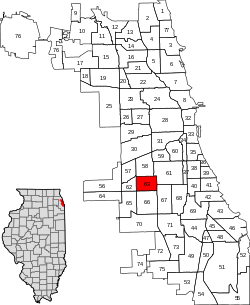Gage Park | |
|---|---|
| Community Area 63 - Gage Park | |
 Gage Park branch of Chicago Public Library on 55th Street. | |
 Location within the city of Chicago | |
| Coordinates: 41°47.4′N87°41.4′W / 41.7900°N 87.6900°W | |
| Country | |
| State | |
| County | Cook |
| City | Chicago |
| Neighborhoods | list
|
| Area | |
• Total | 2.24 sq mi (5.80 km2) |
| Population (2020) [1] | |
• Total | 39,540 |
| • Density | 17,700/sq mi (6,820/km2) |
| Demographics (2020) | |
| • White | 3.6% |
| • Black | 4.7% |
| • Hispanic | 91.0% |
| • Asian | 0.7% |
| • Other | 0.1% |
| Educational Attainment (2020) [1] | |
| • High School Diploma or Higher | 67.4% |
| • Bachelor's Degree or Higher | 8.6% |
| Time zone | UTC-6 (CST) |
| • Summer (DST) | UTC-5 (CDT) |
| ZIP Codes | parts of 60609, 60629, 60632 and 60636 |
| Median income (2020) [1] | $42,271 |
| Source: U.S. Census, Record Information Services | |
Gage Park is one of Chicago's 77 well-defined community areas, located on the city's southwest side; it is also the name of a park within the neighborhood. Gage Park's population is largely working-class, and its housing stock is mostly bungalows. For generations, the neighborhood was predominantly Eastern European and Irish Catholic. Today, the neighborhood is predominantly Hispanic and remains overwhelmingly Catholic. Gage Park is bounded by 49th Street to the north, 59th Street to the south, Central Park Ave to the west, and Leavitt Street to the east.
